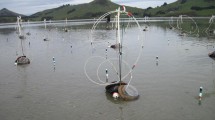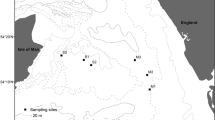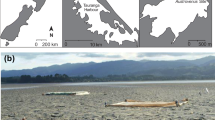Abstract
Microphytobenthos (MPB) is one of the most important primary producers in coastal and estuarine ecosystems, where it plays a substantial role in many ecological functions. Although the influence of several environmental factors on MPB biomass and productivity is well documented, the effects of macrofaunal bioturbation remain poorly assessed. The purpose of this study was to experimentally quantify the influence of sediment bioturbation processes (that is, sediment reworking and bioirrigation) on biogeochemical fluxes across the sediment–water interface and MPB biomass and photosynthetic capacities. Two infaunal deposit feeders (the polychaete Hediste diversicolor and the bivalve Scrobicularia plana) exhibiting contrasting bioturbation modes and rates were studied as model organisms. They differently affected MPB biomass and photosynthetic performance. Hence, through an intense bioirrigation activity and the stimulation of nutrient fluxes (NH4+ , NOx, PO42− and dSi) at the sediment surface, H. diversicolor enhanced MPB growth, which seemed to compensate for its direct consumption. Conversely, high sediment reworking rates generated by S. plana, associated with an extensive grazing pressure, drastically limited the development of MPB at the sediment surface. The negative impact of bivalves on MPB biomass increased with increasing density, whereas there was no significant relationship with polychaete density, possibly due to trophic competition. This study demonstrates that macrofaunal bioturbation is a key factor regulating MPB dynamics, with complex interactions that can result in a net either positive or negative effect depending on dominant species functional traits and abundances. This may, in particular, explain the strong spatial and temporal variability of the microbenthic primary productivity in intertidal mudflats.









Similar content being viewed by others
Data Availability
The datasets used for this study have been posted on the Environmental Data Initiative (EDI). The data package is available for download here: https://doi.org/10.6073/pasta/1b2f0f55dfd3c0d83715effa7da00546(Accessed 2022-12-15).
References
Aller RC, Cochran JK. 2019. The critical role of bioturbation for particle dynamics, priming potential, and organic C remineralization in marine sediments: local and basin scales. Front Earth Sci 7:157.
Aller RC. 1980. Diagenetic processes near the sediment-water interface of Long Island sound. In: Advances in Geophysics. Vol. 22. Elsevier. pp 237–350. https://linkinghub.elsevier.com/retrieve/pii/S0065268708600679. Last accessed 11/02/2021
Aller RC. 1994. Bioturbation and remineralization of sedimentary organic matter: effects of redox oscillation. Chem Geol:15.
Andersen FØ, Kristensen E. 1988. The influence of macrofauna on estuarine benthic community metabolism: a microcosm study. Mar Biol 99:591–603.
Anderson MJ. 2001. A new method for non-parametric multivariate analysis of variance: non-parametric MANOVA for ecology. Austral Ecol 26:32–46.
Anderson MJ. 2006. Distance-based tests for homogeneity of multivariate dispersions. Biometrics 62:245–253.
Anderson MJ, Gorley RN, Clarke KR. 2008. PERMANOVA+ for PRIMER. Guide to software and statistical methods. Plymouth, UK
Andersson JH, Middelburg JJ, Soetaert K. 2006. Identifiability and uncertainty analysis of bio-irrigation rates. J Mar Res 64:407–429.
Bradshaw C, Kumblad L, Fagrell A. 2006. The use of tracers to evaluate the importance of bioturbation in remobilising contaminants in Baltic sediments. Estuar Coast Shelf Sci 66:123–134.
Braeckman U, Provoost P, Gribsholt B, Van Gansbeke D, Middelburg J, Soetaert K, Vincx M, Vanaverbeke J. 2010. Role of macrofauna functional traits and density in biogeochemical fluxes and bioturbation. Mar Ecol Prog Ser 399:173–186.
Burdige DJ. 2006. Geochemistry of marine sediments. Princeton University Press.
Cartaxana P, Vieira S, Ribeiro L, Rocha RJ, Cruz S, Calado R, da Silva JM. 2015. Effects of elevated temperature and CO2 on intertidal microphytobenthos. BMC Ecol 15:10.
Chennu A, Volkenborn N, de Beer D, Wethey DS, Woodin SA, Polerecky L. 2015. Effects of bioadvection by Arenicola marina on microphytobenthos in permeable sediments. Vopel KC, editor. PLOS ONE 10:e0134236.
Christensen B, Vedel A, Kristensen E. 2000. Carbon and nitrogen fluxes in sediment inhabited by suspension-feeding (Nereis diversicolor) and non-suspension-feeding (N. virens) polychaetes. Mar Ecol Prog Ser 192:203–217.
Como S, Lefrancois C, Maggi E, Antognarelli F, Dupuy C. 2014. Behavioral responses of juvenile golden gray mullet Liza aurata to changes in coastal temperatures and consequences for benthic food resources. J Sea Res 92:66–73.
Consalvey M, Perkins RG, Paterson DM, Underwood GJC. 2005. PAM fluorescence: a beginners guide for benthic diatomists. Diatom Res 20:1–22.
Daggers TD, Oevelen D, Herman PMJ, Boschker HTS, Wal D. 2020. Spatial variability in macrofaunal diet composition and grazing pressure on microphytobenthos in intertidal areas. Limnol Oceanogr 65:2819–2834.
Davey JT. 1994. The architecture of the burrow of Nereis diversicolor and its quantification in relation to sediment-water exchange. J Exp Mar Biol Ecol 179:115–129.
Duport E, Stora G, Tremblay P, Gilbert F. 2006. Effects of population density on the sediment mixing induced by the gallery-diffusor Hediste (Nereis) diversicolor O.F. Müller, 1776. J Exp Mar Biol Ecol 336:33–41.
Dyson KE, Bulling MT, Solan M, Hernandez-Milian G, Raffaelli DG, White PCL, Paterson DM. 2007. Influence of macrofaunal assemblages and environmental heterogeneity on microphytobenthic production in experimental systems. Proc R Soc B Biol Sci 274:2547–2554.
Genty B, Briantais J-M, Baker NR. 1989. The relationship between the quantum yield of photosynthetic electron transport and quenching of chlorophyll fluorescence. Biochim Biophys Acta BBA - Gen Subj 990:87–92.
Gilbert F, Kristensen E, Aller RC, Banta GT, Archambault P, Belley R, Bellucci LG, Calder L, Cuny P, de Montaudouin X, Eriksson SP, Forster S, Gillet P, Godbold JA, Glud RN, Gunnarsson J, Hulth S, Lindqvist S, Maire A, Michaud E, Norling K, Renz J, Solan M, Townsend M, Volkenborn N, Widdicombe S, Stora G. 2021. Sediment reworking by the burrowing polychaete Hediste diversicolor modulated by environmental and biological factors across the temperate North Atlantic. A tribute to Gaston Desrosiers. J Exp Mar Biol Ecol 541:151588.
Glud RN. 2008. Oxygen dynamics of marine sediments. Mar Biol Res 4:243–289.
Honeywill C, Paterson D, Hagerthey S. 2002. Determination of microphytobenthic biomass using pulse-amplitude modulated minimum fluorescence. Eur J Phycol 37:485–492.
Hope JA, Hewitt J, Pilditch CA, Savage C, Thrush SF. 2020a. Effect of nutrient enrichment and turbidity on interactions between microphytobenthos and a key bivalve: implications for higher trophic levels. Front Mar Sci 7:695.
Hope JA, Paterson DM, Thrush SF. 2020b. The role of microphytobenthos in soft-sediment ecological networks and their contribution to the delivery of multiple ecosystem services. Van Alstyne K, editor. J Ecol 108:815–830.
Hughes RN. 1969. A study of feeding in Scrobicularia plana. J Mar Biol Assoc U K 49:805–823.
Ieno E, Solan M, Batty P, Pierce G. 2006. How biodiversity affects ecosystem functioning: roles of infaunal species richness, identity and density in the marine benthos. Mar Ecol Prog Ser 311:263–271.
Jardine CB, Bond AL, Davidson PJA, Butler RW, Kuwae T. 2015. Biofilm consumption and variable diet composition of western sandpipers (Calidris mauri) during migratory stopover. Pond DW, editor. PLOS ONE 10:e0124164.
Jesus B, Mendes CR, Brotas V, Paterson DM. 2006. Effect of sediment type on microphytobenthos vertical distribution: Modelling the productive biomass and improving ground truth measurements. J Exp Mar Biol Ecol 332:60–74.
Jones HFE, Pilditch CA, Hamilton DP, Bryan KR. 2017. Impacts of a bivalve mass mortality event on an estuarine food web and bivalve grazing pressure. N Z J Mar Freshw Res 51:370–392.
Kennedy P, Kennedy H, Papadimitriou S. 2005. The effect of acidification on the determination of organic carbon, total nitrogen and their stable isotopic composition in algae and marine sediment. Rapid Commun Mass Spectrom 19:1063–1068.
Krause E, Wichels A, Giménez L, Lunau M, Schilhabel MB, Gerdts G. 2012. Small changes in pH have direct effects on marine bacterial community composition: a microcosm approach. Kirchman DL, editor. PLoS ONE 7:e47035.
Kristensen K, Hansen K. 1999. Transport of carbon dioxide and ammonium in bioturbated (Nereis diversicolor) coastal, marine sediments. Biogeochemistry 45:147–168.
Kristensen E, Penha-Lopes G, Delefosse M, Valdemarsen T, Quintana C, Banta G. 2012. What is bioturbation? The need for a precise definition for fauna in aquatic sciences. Mar Ecol Prog Ser 446:285–302.
Kristensen E, Neto JM, Lundkvist M, Frederiksen L, Pardal MÂ, Valdemarsen T, Flindt MR. 2013. Influence of benthic macroinvertebrates on the erodability of estuarine cohesive sediments: Density- and biomass-specific responses. Estuar Coast Shelf Sci 134:80–87.
Lepore BJ, Barak P. 2009. A colorimetric microwell method for determining bromide concentrations. Soil Sci Soc Am J 73:1130–1136.
Lindqvist S, Gilbert F, Eriksson SP, Hulth S. 2013. Activities by Hediste diversicolor under different light regimes: Experimental quantification of particle reworking using time-resolved imaging. J Exp Mar Biol Ecol 448:240–249.
Lohrer AM, Thrush SF, Hunt L, Hancock N, Lundquist C. 2005. Rapid reworking of subtidal sediments by burrowing spatangoid urchins. J Exp Mar Biol Ecol 321:155–169.
Lundkvist M, Gangelhof U, Lunding J, Flindt MR. 2007. Production and fate of extracellular polymeric substances produced by benthic diatoms and bacteria: A laboratory study. Estuar Coast Shelf Sci 75:337–346.
MacIntyre HL, Kana TM, Anning T, Geider RJ. 2002. Photoacclimatation of photosynthesis irradiance response curves and photosynthetic pigments in microalgae and cyanobacteria. J Phycol 38:17–38.
Maire O, Lecroart P, Meysman F, Rosenberg R, Duchêne J, Grémare A. 2008. Quantification of sediment reworking rates in bioturbation research: a review. Aquat Biol 2:219–238.
Marinelli RL, Williams TJ. 2003. Evidence for density-dependent effects of infauna on sediment biogeochemistry and benthic–pelagic coupling in nearshore systems. Estuar Coast Shelf Sci 57:179–192.
McMinn A, Hegseth EN. 2004. Quantum yield and photosynthetic parameters of marine microalgae from the southern Arctic Ocean, Svalbard. J Mar Biol Assoc U K 84:865–871.
Méléder V, Savelli R, Barnett A, Polsenaere P, Gernez P, Cugier P, Lerouxel A, Le Bris A, Dupuy C, Le Fouest V, Lavaud J. 2020. Mapping the intertidal microphytobenthos gross primary production part I: Coupling multispectral remote sensing and physical modeling. Front Mar Sci 7:520.
Mermillod-Blondin F, Rosenberg R, François-Carcaillet F, Norling K, Mauclaire L. 2004. Influence of bioturbation by three benthic infaunal species on microbial communities and biogeochemical processes in marine sediment. Aquat Microb Ecol 36:271–284.
Morelle J, Maire O, Richard A, Slimani A, Orvain F. 2021. Contrasted impact of two macrofaunal species (Hediste diversicolor and Scrobicularia plana) on microphytobenthos spatial distribution and photosynthetic activity at microscale. Mar Environ Res 163:105228.
Nizzoli D, Bartoli M, Cooper M, Welsh DT, Underwood GJC, Viaroli P. 2007. Implications for oxygen, nutrient fluxes and denitrification rates during the early stage of sediment colonisation by the polychaete Nereis spp. in four estuaries. Estuar Coast Shelf Sci 75:125–134.
Orvain F. 2005. A model of sediment transport under the influence of surface bioturbation: generalisation to the facultative suspension-feeder Scrobicularia plana. Mar Ecol Prog Ser 286:43–56.
Orvain F, Galois R, Barnard C, Sylvestre A, Blanchard G, Sauriau P-G. 2003. Carbohydrate production in relation to microphytobenthic biofilm development: an integrated approach in a tidal mesocosm. Microb Ecol 45:237–251.
Orvain F, Sauriau P, Sygut A, Joassard L, Le Hir P. 2004. Interacting effects of Hydrobia ulvae bioturbation and microphytobenthos on the erodibility of mudflat sediments. Mar Ecol Prog Ser 278:205–223.
Papaspyrou S, Thessalou-Legaki M, Kristensen E. 2010. The influence of infaunal (Nereis diversicolor) abundance on degradation of organic matter in sandy sediments. J Exp Mar Biol Ecol 393:148–157.
Parkhill J-P, Maillet G, Cullen JJ. 2001. Fluorescence-based maximal quantum yield for PSII as a diagnostic of nutrient stress. J Phycol 37:517–529.
Pascal L, Chaillou G, Nozais C, Cool J, Bernatchez P, Letourneux K, Archambault P. 2022. Benthos response to nutrient enrichment and functional consequences in coastal ecosystems. Mar Environ Res 175:105584.
Perkins RG, Kromkamp JC, Serôdio J, Lavaud J, Jesus B, Mouget JL, Lefebvre S, Forster RM. 2010. The application of variable chlorophyll fluorescence to microphytobenthic biofilms. In: Suggett DJ, Prášil O, Borowitzka MA, editors. Chlorophyll a fluorescence in aquatic sciences: methods and applications. Dordrecht: Springer Netherlands. pp 237–75. http://link.springer.com/https://doi.org/10.1007/978-90-481-9268-7_12. Last accessed 11/02/2021
Posey MH, Alphin TD, Cahoon L, Lindquist D, Becker ME. 1999. Interactive effects of nutrient additions and predation on infaunal communities. Estuaries 22:785.
Renz J, Forster S. 2014. Effects of bioirrigation by the three sibling species of Marenzelleria spp. on solute fluxes and porewater nutrient profiles. Mar Ecol Prog Ser 505:145–159.
Romero-Ramirez A, Grémare A, Bernard G, Pascal L, Maire O, Duchêne JC. 2016. Development and validation of a video analysis software for marine benthic applications. J Mar Syst 162:4–17.
Santos S, Luttikhuizen PC, Campos J, Heip CHR, van der Veer HW. 2011. Spatial distribution patterns of the peppery furrow shell Scrobicularia plana (da Costa, 1778) along the European coast: A review. J Sea Res 66:238–247.
Savelli R, Bertin X, Orvain F, Gernez P, Dale A, Coulombier T, Pineau P, Lachaussée N, Polsenaere P, Dupuy C, Le Fouest V. 2019. Impact of chronic and massive resuspension mechanisms on the microphytobenthos dynamics in a temperate intertidal mudflat. J Geophys Res Biogeosciences 124:3752–3777.
Scaps P. 2002. A review of the biology, ecology and potential use of the common ragworm Hediste diversicolor (O.F. Müller) (Annelida: Polychaeta). Hydrobiologia 470:203–218.
Snelgrove PVR, Soetaert K, Solan M, Thrush S, Wei C-L, Danovaro R, Fulweiler RW, Kitazato H, Ingole B, Norkko A, Parkes RJ, Volkenborn N. 2018. Global carbon cycling on a heterogeneous seafloor. Trends Ecol Evol 33:96–105.
Stal LJ. 2010. Microphytobenthos as a biogeomorphological force in intertidal sediment stabilization. Ecol Eng 36:236–245.
Tang M, Kristensen E. 2007. Impact of microphytobenthos and macroinfauna on temporal variation of benthic metabolism in shallow coastal sediments. J Exp Mar Biol Ecol 349:99–112.
Underwood GJC, Kromkamp J. 1999. Primary production by phytoplankton and microphytobenthos in estuaries. In: Advances in Ecological Research. Vol. 29. Elsevier. pp 93–153. https://linkinghub.elsevier.com/retrieve/pii/S0065250408601920. Last accessed 11/02/2021
Van Colen C, Ong EZ, Briffa M, Wethey DS, Abatih E, Moens T, Woodin SA. 2020. Clam feeding plasticity reduces herbivore vulnerability to ocean warming and acidification. Nat Clim Change 10:162–166.
Volkenborn N, Hedtkamp SIC, van Beusekom JEE, Reise K. 2007. Effects of bioturbation and bioirrigation by lugworms (Arenicola marina) on physical and chemical sediment properties and implications for intertidal habitat succession. Estuar Coast Shelf Sci 74:331–343.
Volkenborn N, Meile C, Polerecky L, Pilditch CA, Norkko A, Norkko J, Hewitt JE, Thrush SF, Wethey DS, Woodin SA. 2012. Intermittent bioirrigation and oxygen dynamics in permeable sediments: An experimental and modeling study of three tellinid bivalves. J Mar Res 70:794–823.
Wiesebron LE, Steiner N, Morys C, Ysebaert T, Bouma TJ. 2021. Sediment bulk density effects on benthic macrofauna burrowing and bioturbation behavior. Front Mar Sci 8:707785.
Zwarts L, Wanink J. 1989. Siphon size and burying depth in deposit- and suspension-feeding benthic bivalves. Mar Biol 100:227–240.
Acknowledgements
The authors thank especially Thomas Lecarpentier and Edith Parlanti, for their participation in the sampling and the experiment. We also thank Nicolas Savoye and Nathalie Labourdette for their assistance with laboratory work and to MDPI editing service for correcting the English of our manuscript. We are grateful to the GIP Seine-Aval, and especially Nicolas Bacq for his implication in the PHARE-SEE project.
Funding
This research was funded by the GIP Seine-Aval program through the research project SA6-PHARE SEE (2017–2020).
Author information
Authors and Affiliations
Corresponding author
Ethics declarations
Conflict of interest
The authors declare that they have no conflicts of interest.
Ethical Standards
All the samples were taken with the agreement of Thomas Lecarpentier ("maison de l’estuaire"), a representative of the Reserve, who was our contact throughout the project. No further authorization was required, and this field study did not involve endangered or protected species.
Rights and permissions
Springer Nature or its licensor (e.g. a society or other partner) holds exclusive rights to this article under a publishing agreement with the author(s) or other rightsholder(s); author self-archiving of the accepted manuscript version of this article is solely governed by the terms of such publishing agreement and applicable law.
About this article
Cite this article
Richard, A., Orvain, F., Morelle, J. et al. Impact of Sediment Bioturbation on Microphytobenthic Primary Producers: Importance of Macrobenthic Functional Traits. Ecosystems 26, 1077–1094 (2023). https://doi.org/10.1007/s10021-022-00817-x
Received:
Accepted:
Published:
Issue Date:
DOI: https://doi.org/10.1007/s10021-022-00817-x




